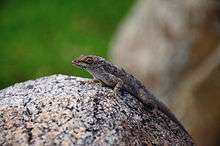Anolis stratulus
| Barred anole | |
|---|---|
 | |
| Scientific classification | |
| Kingdom: | Animalia |
| Phylum: | Chordata |
| Class: | Reptilia |
| Order: | Squamata |
| Suborder: | Iguania |
| Family: | Polychrotidae |
| Genus: | Ctenonotus |
| Species: | C. stratulus |
| Binomial name | |
| Ctenonotus stratulus (Cope, 1861) | |
| Synonyms[1] | |
|
Anolis stratulus | |
The barred anole (Ctenonotus stratulus), also known as the spotted anole or St. Thomas anole,[2] is a species of anole found in Puerto Rico, the British Virgin Islands, and the United States Virgin Islands. The species of lizards had its scientific name changed recently from Anolis stratulus to Ctenonotus stratulus according to Integrated Taxonomic Information System (ITIS).[3] The species belong to the family Polychrotidae of reptiles.
Geographic range
The C. stratulus distribution includes Puerto Rico and the many islands surrounding it such a Vieques and Culebra.[4] In Puerto Rico it is commonly found in the Maricao Reserve Forest, the Guanica Forest,[5] and the Luquillo Mountains.[4] It is also present in Cayo Santiago, Humacao.[6] C. stratulus is also found but at a lesser extent in the coffee plantations of barrios Sabana Grande, Vivi Arriba, and Mameye. Also in the municipality of Utuado, and in the barrios of Cialito and Pozas in Ciales.[7] Outside of Puerto Rico the species can be found in the British Virgin Islands,[4][5] and it is a commonly observed in the Northern United States Virgin Islands, specifically the north side of St. Thomas.[8]
Description
The C. stratulus is a small lizards, measuring 40 to 45 mm (1.6 to 1.8 in) from snout to vent.
The male C. stratulus do not have dorsal crest or tail fin common in most anolis lizards. The species range of color is from gray to brownish gray. It also has a pale colored, hour-glass shaped spots coming from the nape to tail, it also has a black, crescent shape behind the eye. The throat of the C. stratulus is noted with raised brown ridges and the dewlap color is orange with light yellow scales. Its flanks are marked with small dark spots.[9]
Habitat association
A trunk-crown lizard that is mostly observed on tree trunk and occasionally in grasses. The species can be seen in both shaded and sunny areas.[7] C. stratulus has an altitude range from sea level to 365 meters. It also prefers xerophytic and mesophitic environments rather than hydrophitic forests with a high level of precipitation.[4][5]
The C. stratulus found in the El Yunque national park in Puerto Rico generally occupy the Tabonuco tree canopy, which range from 10 to 20 meters in height from the ground. the lizard prefers small branches and has a range 6 meters for foraging and mating.[5]
Diet and dietary habits
C. stratulus has a diet consisting of mainly ants, but also consumes beetles, spiders, and flies.[4][5] It is also noted for eating more during the rainy season than during the dry season.[5]
See also
- List of amphibians and reptiles of U.S.Virgin Islands
- List of amphibians and reptiles of Puerto Rico
- List of endemic fauna of Puerto Rico
- List of Anolis lizards
References
| Wikimedia Commons has media related to Anolis stratulus. |
- ↑ http://eol.org/pages/1057135/names/synonyms
- ↑ "Anolis stratulus". The Reptile Database.
- ↑ http://www.itis.gov/servlet/SingleRpt/SingleRpt?search_topic=TSN&search_value=564562
- 1 2 3 4 5 Reagan, D.P. (1996). The role of amphibians and reptiles in a West Indian rain forest food web, pp. 217-227. In R.Powell and R.W. Henderson (eds.) Contributions to West Indian Herpetology: A Tribute to Albert Schwartz. Society for the Study of Amphibians and Reptiles. Contributions to Herpetology, volume 12.
- 1 2 3 4 5 6 Rivero, Juan A. (1978). Los anfibios y reptiles de Puerto Rico. Editorial Universitaria. Universidad de Puerto Rico, San Juan.
- ↑ Heatwole, H. et al. Herpetogeography of Puerto Rico I. Herpetofauna of Cayo Santiago and Cayo Batata. Caribbean Journal of Science 3:1-5.
- 1 2 Borkhataria, R.R. (1993). Ecological and political implications of conversion from shade to sun coffee in Puerto Rico. Thesis (MS). North Carolina State University.
- ↑ Platenberg, R.J.; F.E. Hayes; D.B. McNair; and J.J. Pierce (2005). A Comprehensive Wildlife Conservation Strategy for the U.S. Virgin Islands. Division of Fish and Wildlife, St. Thomas. 251 pp.
- ↑ http://www.fs.usda.gov/detail/elyunque/learning/nature-science/?cid=fsbdev3_042992